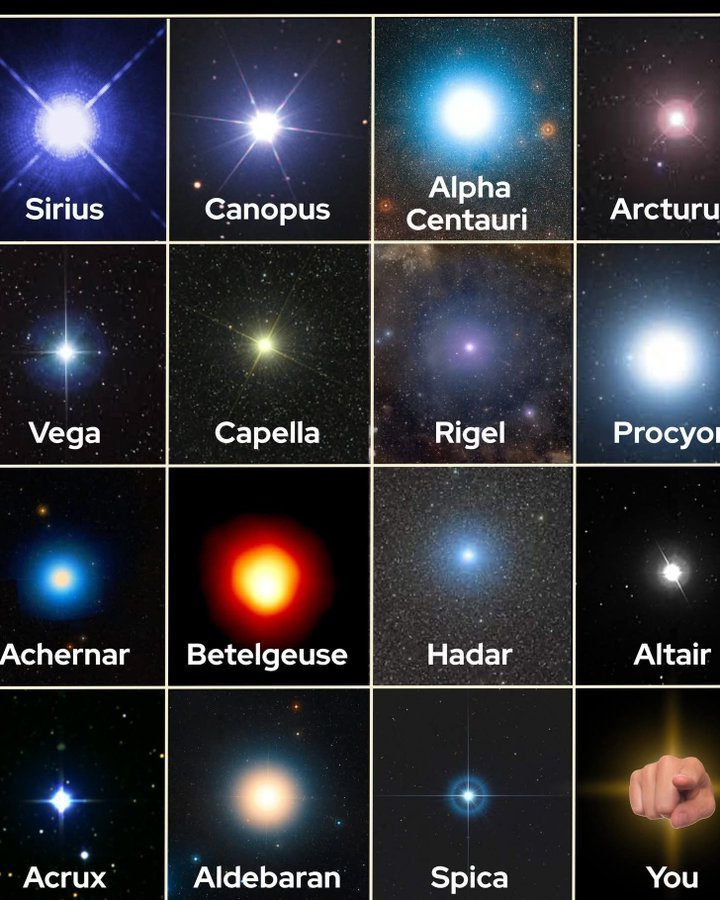[GUEST ACCESS MODE: Data is scrambled or limited to provide examples. Make requests using your API key to unlock full data. Check https://lunarcrush.ai/auth for authentication information.]  Black Hole [@konstructivizm](/creator/twitter/konstructivizm) on x 753.8K followers Created: 2025-07-08 05:21:00 UTC XX of the brightest stars, Ever look up and notice how a few stars seem to blaze brighter than the rest? Here’s your cosmic cheat sheet to the brightest stars in the night sky (not counting the Sun), ranked by how brilliant they appear from Earth – and why they shine so bright: X. Sirius (–1.46, Canis Major) The brightest star we see! Nicknamed the Dog Star, it’s a binary system just XXX light-years away. X. Canopus (–0.74, Carina) Visible mainly from the Southern Hemisphere, this supergiant is XXX light-years distant and XXXXXX times more luminous than the Sun. X. Alpha Centauri (–0.27, Centaurus) The closest star system to us at just over X light-years, home to Proxima Centauri — our nearest stellar neighbor. X. Arcturus (–0.05, Boötes) The brightest star in the northern celestial hemisphere — a massive red giant nearing the end of its life. X. Vega (+0.03, Lyra) Once the North Star and destined to be again. It’s one of the most studied stars ever. X. Capella (+0.08, Auriga) Looks like a single point, but it’s actually a system of four stars in a gravitational dance. X. Rigel (+0.12, Orion) A hot, blue supergiant marking Orion’s left foot — and one of the most luminous stars we can see. X. Procyon (+0.38, Canis Minor) Just XXXX light-years away, it has a white dwarf companion and a spot on our list of stellar VIPs. X. Achernar (+0.46, Eridanus) Spins so fast it’s flattened at the poles — one of the most oblate stars known. XX. Betelgeuse (~+0.4 to +1.3, Orion) This red supergiant made headlines when it dimmed in 2019 — maybe a hint it’s preparing to explode (eventually). XX. Hadar (+0.61, Centaurus) A Southern Hemisphere gem and one of the pointer stars to the Southern Cross. XX. Altair (+0.77, Aquila) Another rapid spinner — so fast, it’s shaped like an egg. Part of the Summer Triangle. XX. Acrux (+0.77, Crux) The brightest star in the Southern Cross, and a whole system of stars masquerading as one. XX. Aldebaran (+0.85, Taurus) The red “eye” of Taurus the Bull, shining near the Hyades star cluster. XX. Spica (+0.97, Virgo) A massive, searing binary system anchoring the Virgo constellation.  XXXXX engagements  **Related Topics** [blaze](/topic/blaze) [black hole](/topic/black-hole) [Post Link](https://x.com/konstructivizm/status/1942453845961105729)
[GUEST ACCESS MODE: Data is scrambled or limited to provide examples. Make requests using your API key to unlock full data. Check https://lunarcrush.ai/auth for authentication information.]
 Black Hole @konstructivizm on x 753.8K followers
Created: 2025-07-08 05:21:00 UTC
Black Hole @konstructivizm on x 753.8K followers
Created: 2025-07-08 05:21:00 UTC
XX of the brightest stars,
Ever look up and notice how a few stars seem to blaze brighter than the rest?
Here’s your cosmic cheat sheet to the brightest stars in the night sky (not counting the Sun), ranked by how brilliant they appear from Earth – and why they shine so bright:
X. Sirius (–1.46, Canis Major) The brightest star we see! Nicknamed the Dog Star, it’s a binary system just XXX light-years away.
X. Canopus (–0.74, Carina) Visible mainly from the Southern Hemisphere, this supergiant is XXX light-years distant and XXXXXX times more luminous than the Sun.
X. Alpha Centauri (–0.27, Centaurus) The closest star system to us at just over X light-years, home to Proxima Centauri — our nearest stellar neighbor.
X. Arcturus (–0.05, Boötes) The brightest star in the northern celestial hemisphere — a massive red giant nearing the end of its life.
X. Vega (+0.03, Lyra) Once the North Star and destined to be again. It’s one of the most studied stars ever.
X. Capella (+0.08, Auriga) Looks like a single point, but it’s actually a system of four stars in a gravitational dance.
X. Rigel (+0.12, Orion) A hot, blue supergiant marking Orion’s left foot — and one of the most luminous stars we can see.
X. Procyon (+0.38, Canis Minor) Just XXXX light-years away, it has a white dwarf companion and a spot on our list of stellar VIPs.
X. Achernar (+0.46, Eridanus) Spins so fast it’s flattened at the poles — one of the most oblate stars known.
XX. Betelgeuse (~+0.4 to +1.3, Orion) This red supergiant made headlines when it dimmed in 2019 — maybe a hint it’s preparing to explode (eventually).
XX. Hadar (+0.61, Centaurus) A Southern Hemisphere gem and one of the pointer stars to the Southern Cross.
XX. Altair (+0.77, Aquila) Another rapid spinner — so fast, it’s shaped like an egg. Part of the Summer Triangle.
XX. Acrux (+0.77, Crux) The brightest star in the Southern Cross, and a whole system of stars masquerading as one.
XX. Aldebaran (+0.85, Taurus) The red “eye” of Taurus the Bull, shining near the Hyades star cluster.
XX. Spica (+0.97, Virgo) A massive, searing binary system anchoring the Virgo constellation.

XXXXX engagements
Related Topics blaze black hole